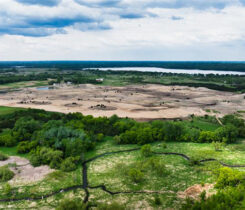Soil: All it’s cracked up to be
Silly puns might cause a superintendent to crack up. Cracking soil will not.
In areas affected by drought, golf courses are seeing more cracks in their soil. Are these serious?
Blame them on smectites and vertisols. According to Eric Brevik, soils professor at Dickinson State University, Dickinson, N.D., some soils have a high content of clay minerals known as smectites. This is especially true in the Gulf Coastal Plain of Texas, the Mississippi River Valley from Illinois to the Gulf Coast, central Montana, western South Dakota and the Red River Valley through North Dakota and Minnesota. When smectite clays get wet, water moves into a space between the structural units that make up the clay mineral. The presence of the water molecules pushes the structural units apart, causing the clay mineral to expand, or swell.
When these clays dry out, the water molecules are removed from the inter-structural spaces and the clays shrink. As shrinking takes place in millions of clay structural units in a volume of soil, the shrinking can be enough to create large cracks in the soil. Soils with a high shrink-swell clay content are known as vertisols. In addition to those several places in the United States, vertisols are found in central India, eastern Australia, and eastern Sudan and South Sudan.










